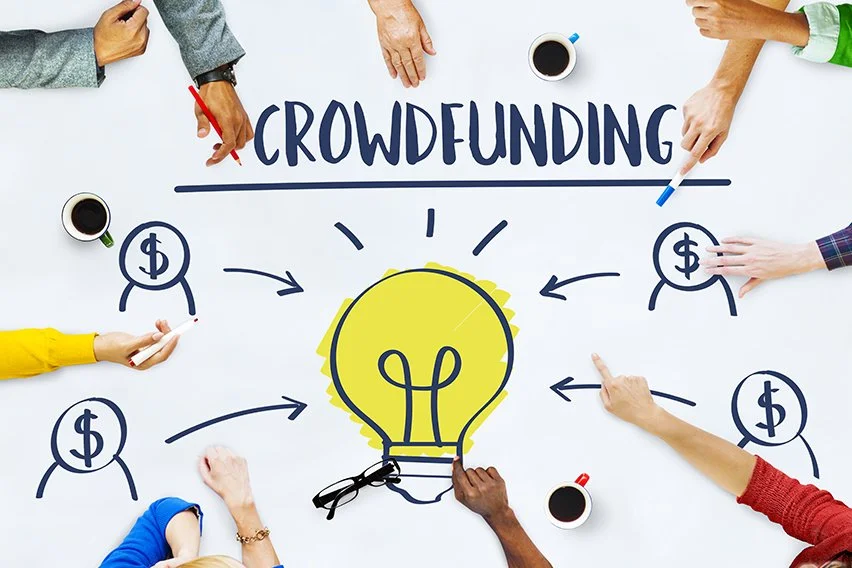
Crowdfunding is a method of raising funds for businesses, projects, or charitable causes by collecting relatively small amounts of money from a large number of contributors through online platforms, often utilizing social networks and crowdfunding platforms (CFPs). According to a 2015CF Massolution.com report, crowdfunding encompasses any form of capital formation where both funding needs and purposes are communicated widely through an open call, in a forum where the call can be evaluated by a large group of individuals—the crowd. This typically takes place on the Internet. Individuals, charities, or companies can create campaigns for specific causes, and anyone can contribute. Crowdfunders can include friends, family, supporters of a cause or project, and members of an online community. Organizations, businesses, and individuals alike can use crowdfunding for various projects, such as charitable causes, creative endeavors, business startups, school tuition, or personal expenses.
How Crowdfunding Works
Crowdfunding has created opportunities for entrepreneurs to raise hundreds of thousands or millions of dollars from anyone with money to invest. It provides a platform for anyone with an idea to pitch it in front of potential investors. Typically, startup companies seeking financial support advertise their campaigns on crowdfunding websites and offer rewards to donors—those willing to provide funding at certain levels. In other words, higher levels of financial support might yield multiple products, a higher-end version, or public recognition. Crowdfunding campaigns have fundraising goals and typically have a 30-90 day duration, depending on the platform. Some platforms transfer all the money raised at the conclusion of the campaign, regardless of whether the goal has been reached, while others use an all-or-nothing model that returns funds to individual donors if the goal is not met.
Crowdfunding for charitable projects serves as a connection platform, linking individuals seeking expensive medical care for themselves or loved ones with potential donors worldwide.
According to a 2015CF Massolution.com research report, in 2014, the worldwide crowdfunding volume reached $16.2 billion, reflecting an annual growth rate of 167%, accelerating from the 125% growth experienced in 2013 with a funding volume of $6.1 billion. According to Statista, the global crowdfunding market was valued at $12.27 billion in 2021 and was forecasted to double by 2027, growing at a compound annual growth rate (CAGR) of 11%. The current crowdfunding volume in the US and Canada is $73.93 billion.
Some of the most common crowdfunding platforms include Kickstarter, Indiegogo, and GoFundMe, attracting hundreds of thousands of people hoping to create or support the next big thing. In recent years, platforms like Patreon and Substack have extended crowdfunding to offer a way for creative individuals—artists, writers, musicians, or podcasters—to sustain their work by receiving a steady source of income.
Crowdfunding Models:
Non-Financial Crowdfunding:
Donation-Based: This type involves individuals, families, or non-profits making donations as gifts for a cause without expecting financial returns. Owners of donation-based crowdfunding campaigns typically request funds for independent projects or initiatives that appeal to others with similar interests, with no legal obligation for a return on the funds provided.
Reward-Based: In reward-based campaigns, crowdfunders provide funds to support a campaign in return for a benefit or reward. This could be a product produced with the help of the funds collected during the campaign. The rewards vary based on the size of the donation, incentivizing higher contributions. For example, participants may receive a T-shirt or tickets to events based on their donation.
Financial Crowdfunding:
Lending or Debt Crowdfunding: Investors collectively fund a project, and the borrower agrees to pay back the money raised with interest by a certain future date. Lending-based crowdfunding can include peer-to-peer (P2P) and peer-to-business (P2B) lending.
Equity Crowdfunding: Entrepreneurs raise money for a project by selling a portion of the business to its funders. Equity crowdfunding investors receive ownership shares based on the amount of money they contribute to the project. Also known as securities crowdfunding or investment crowdfunding, it was projected to become the leading source of funding for start-up companies by 2020, ahead of venture capital. The Securities and Exchange Commission (SEC) regulates equity-based crowdfunding in the United States.
Royalty-Based Crowdfunding: Generally involves investors receiving a percentage of revenue derived from a license or a usage-based fee for ongoing use of an asset, rather than interest on a loan or appreciation in capital stock (equity).
According to the 2015CF Massolution.com report, from a worldwide perspective in 2014, donation-based campaigns averaged $3,363, reward-based $3,189, and consumer-based lending campaigns $3,999. In the same year, the average size of a Small and Medium Enterprise (SME) crowdfunded loan was $103,618. The average size of an equity-based campaign in 2014 differed by region, with averages ranging from $175,000 in North America to as much as an average of $342,260 in Asia, where China dominates the crowdfunding market via P2P lending, and $307,474 in Oceania.
Pros and Cons of Crowdfunding
Advantages of crowdfunding include the ability for individuals, businesses, or organizations to connect and mobilize large crowds worldwide to raise money for a specific project. Many individuals affected by natural disasters, hefty medical expenses, or other tragic events, such as house fires, have received financial relief they wouldn’t otherwise have accessed thanks to crowdfunding platforms. Crowdfunding for a start-up company or individual provides access to a larger and more diverse group of investors and supporters. Donation- and reward-based crowdfunding present fewer risks than financial crowdfunding. Additionally, crowdfunding is an excellent way to interact with potential consumers and gauge public opinion on a product.
Disadvantages include exposure to the risk of fraudulent campaigns and, like all e-commerce systems, the inclusion of cyber security risks. For reward-based campaigns, crowdfunders are exposed to fulfillment risk, where the campaign owner may not fulfill the promise to deliver a reward. In equity crowdfunding, if the funding goal is not reached, any pledged finance will be returned to investors, potentially damaging the start-up company’s reputation.
Crowdfunding and Financial Inclusion
The main goal of financial inclusion is to enable individuals and businesses to have meaningful and affordable access to financial products and services within the financial system. This includes access to loans, insurance, pensions, bank accounts, financial advice, and access to securities markets—the key purpose of equity crowdfunding. Small businesses often face difficulties obtaining credit from traditional financial service systems, leading people to seek alternative lending means. The amount of money raised using CFPs worldwide is growing rapidly.



